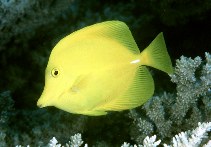| Family: |
Acanthuridae (Surgeonfishes, tangs, unicornfishes), subfamily: Acanthurinae |
| Max. size: |
20 cm TL (male/unsexed) |
| Environment: |
reef-associated; marine; depth range 2 - 46 m |
| Distribution: |
Pacific Ocean: Ryukyu, Mariana, Marshall, Marcus, Wake and Hawaiian islands. Has been reported off the coast of Florida in the Western Central Atlantic (Ref. 51238). |
| Diagnosis: |
Dorsal spines (total): 5-5; Dorsal soft rays (total): 23-26; Anal spines: 3-3; Anal soft rays: 19-22. bright yellow overall (pale in preservative). Sheath of peduncular spine white. Body very deep, its depth 1.4 to 1.75 times in SL. Snout moderately protruding. Mouth small; teeth spatulate, close-set, the edges denticulate. 12 upper and 14 lower teeth in juveniles, and 18 upper and 22 lower teeth in an adult 15 cm SL (Ref 9808). |
| Biology: |
Adults inhabit coral-rich areas of lagoon and seaward reefs from below the surge zone to about 46 m (Ref. 9710). Benthopelagic over rock at 1-81 m (Ref. 58302). They occur singly or in loose groups. Mainly herbivorous, browsing on filamentous algae. Group spawning and pair-spawning by territorial males that court passing females were observed. Spawning activity occurs around the full moon indicating lunar periodicity (Ref. 86544). Spawn in batches throughout the year (Ref. 86544). Presence of a venom gland could not be determined despite the presence of distinct anterolateral grooves; this may be due to the loss of venom glands in adults (Ref. 57406). A popular aquarium fish and the top marine fish export from Hawaii. |
| IUCN Red List Status: |
Least Concern (LC); Date assessed: 07 May 2010 Ref. (130435)
|
| Threat to humans: |
harmless |
Source and more info: www.fishbase.org. For personal, classroom, and other internal use only. Not for publication.

